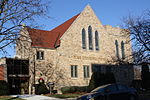Thomas M. and Bridget Blackstock House

The Thomas M. and Bridget Blackstock House is located in Sheboygan, Wisconsin, United States. It was added to the National Register of Historic Places in 1995. The Blackstock House is a two-story, balloon frame, clapboard home designed by architect Arvin Luce Weeks in the Italianate style.The house was originally built for Thomas M. Blackstock, and Irish immigrant who made his fortune from the Phoenix Chair Company and the Sheboygan Mutual Loan, Saving, and Building Association, and his wife, Bridget Blackstock (née Denn). Thomas Blackstock served as a city councilman for three terms, as Mayor of Sheboygan for four, and as a representative to the Michigan House of Representatives.
Excerpt from the Wikipedia article Thomas M. and Bridget Blackstock House (License: CC BY-SA 3.0, Authors, Images).Thomas M. and Bridget Blackstock House
Washington Court, Sheboygan
Geographical coordinates (GPS) Address Nearby Places Show on map
Geographical coordinates (GPS)
| Latitude | Longitude |
|---|---|
| N 43.753644 ° | E -87.708258833333 ° |
Address
Washington Court 517
53081 Sheboygan
Wisconsin, United States
Open on Google Maps










